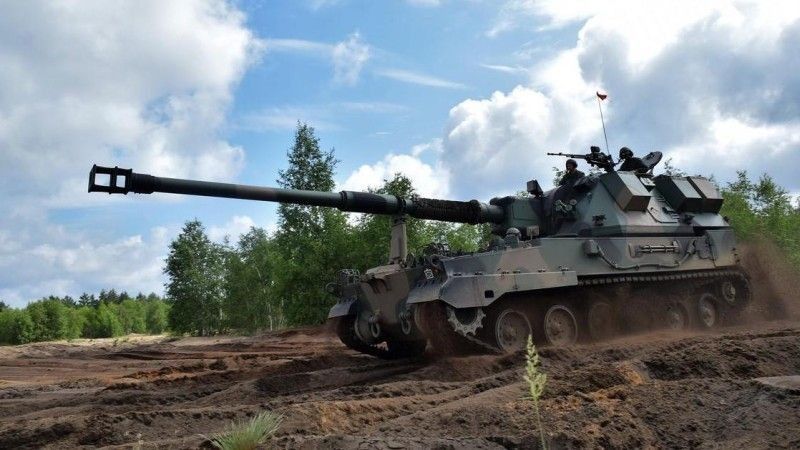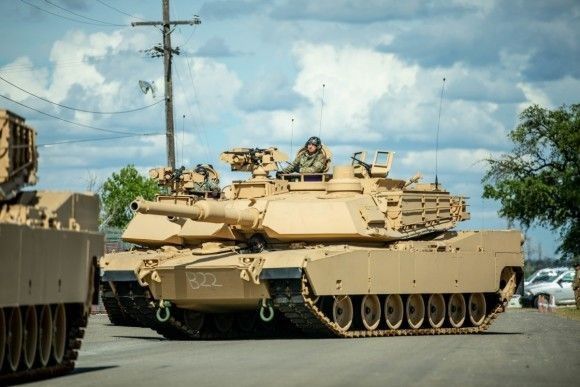Defence Policy
From Drones and Loitering Munitions to Tanks and Howitzers. Polish MoD Unveils Its 2022 Procurement Plans

Photo. mjr Remigiusz Kwieciński, plut. Wiesława Koziarska, st. szer. Waldemar Bagła
The Armament Agency of the Polish MoD is expected to order Krab self-propelled howitzers, ZSSW-30 turret systems for the Rosomak APC, Rosomak-based command vehicles, and GLADIUS loitering munitions - all of the above would be done throughout the year 2022. Furthermore, a batch of MALE UAVs is going to be procured alongside the Abrams MBTs in the US.
Technical modernization is viewed as one of the key elements of the reinforcement of the Polish military potential. It has involved numerous challenges in recent years. In some areas - such as tube artillery systems - the acquisition runs smoothly. In other, however - such as anti-tank weapons, helicopters, warships - the procurement processes suffer from major delays.
Starting from 1st January, Armament Agency has been brought to life, to improve coordination and handling of the procurement processes. Responding to our questions, the spokesman for the Agency, Lt. Col. Krzysztof Płatek, provided us with information on the agreements planned to be signed this year. One needs to note that the list provided to us contains the most important of the planned contracts - but others have also been planned. Some of them are still dependent on the course of negotiation.
Lt. Col. Płatek noted that for the Polish Ministry of Defence, apart from the reinforcement of the national defence capabilities, it is also important to place the orders at the Polish industrial entities, "whenever the domestic contractors remain in possession of proper know-how and capacity, required to effectively and timely deliver military equipment meeting the requirements defined by the military. Not only is this aimed at maintaining, but also consequent establishment of the Polish industrial potential". Płatek also noted that this policy is also tied to the mitigation of the effects that the coronavirus pandemic had on the market.

Among the most imprtant orders planned for 2022, involving the Polish industry, Krzysztof Płatek noted the following: „concluding the agreement with a consortium formed by: HSW S.A. and WB Electronics S.A., concerning the delivery of the ZSSW remote control turret systems, integrated on the Rosomak APC". This system is expected by the military. It is to constitute a relevant reinforcement of the potential of the motorized units. The modern turrets integrated with ATGM launchers would first be integrated onto the Rosomak APCs - the freshly commissioned ones - and on the Borsuk IFVs.
The continued modernization of the Rocket and Artillery component by "procurement of further elements that constitute a part of the REGINA squadron-level fire modules, including more KRAB self-propelled howitzers, and AWR artillery reconnaissance vehicles, for the company-level RAK fire modules". The procurement of more Krab howitzers, stepping outside the scope of the already accomplished agreement concerning the "implementation" module and four already contracted series-manufactured modules (in 2016 - a bit more than 120 howitzers in total, including ones destined for the Artillery and Armament Training Centre in Toruń), may result in a major reinforcement of the 18th Mechanized Division. This unit would be where further artillery elements are expected to be established. One should remember that other divisions also need the Krab howitzers in their inventory. Meanwhile, the AWR reconnaissance vehicles would provide a major capability boost for the Rak elements. They may, or even should, become a foundation for the reconnaissance units of other artillery modules, even if those elements use different platforms.
The MoD also plans to procure C4ISR assets from the PGZ Group, including Rosomak APC-based command vehicles, and AŁC-T digital/transmission communication suites.
This year, the last domestic agreement for the Phase I of the Wisła programme is to be signed, concerning the EOCs that are to be supplied by a consortium led by WZE S.A. Performance contracts are also expected to be concluded in the Narew system programme, involving the PGZ-Narew consortium. The spokesman for the Armament Agency did not list any specific contracts. Nonetheless, agreement concerning missiles would be critical for the Narew programme. The previously released information suggests that Narew performance contracts are all to be signed by 2022.
This year further unmanned systems procurement has also been planned - especially the "contracting of unmanned strike/reconnaissance systems within the framework of the GLADIUS programme", and the agreement is to be signed with the "Polish defence industry". Gladius is a medium-range loitering munitions programme. The assets procured within the framework of this initiative would become a part of the inventory of the Artillery and Rocket Artillery components. In late 2021, the head of the Polish Ministry of Defence announced that major quantities of these munitions would be acquired.
Apart from that, agreements related to "unmanned mini VTOL UAVs within the framework of the WAŻKA programme, and tactical short-range VTOL UAVs, within the framework of the ALBATROS programme" are to be signed, following the conclusions of the ongoing competitive procurement procedures. Mariusz Błaszczak also was announcing the restart of the FlyEye UAV procurement for the rocket/tube artillery units.
The spokesman for the Armament Agency also discussed the expected procurement of weapons from the US. "The changes that took place in the international security environment on the NATO Eastern Flank push us to reinforce the Armed Forces in both the areas related to land platforms and air systems as well, that can be procured, at the shortest possible notice, solely from the United States. In 2022 we are planning to finalize the negotiation on procurement of 250 M1A2 SEPv3 ABRAMS main battle tanks and the auxiliary equipment, and also the first operational-level MALE UAVs", said Płatek.

Photo. Sgt. Calab Franklin/US Army
Even though the Abrams procurement has been known for a couple of months now (as LOR was sent to the US in July - but no Congress notification has been issued), the procurement of ALE UAVs seems to be new. The announcement of the completion of negotiation also suggests that the request could have been submitted already, despite the lack of any official confirmation. Given the willingness to finalize the procurement rapidly, the above intention may refer to the MQ-9 Reaper, or MQ-1C Gray Eagle platforms, used by USAF and the US Army, correspondingly. It remains an open question whether that is related to the situation on the border, and the delays in other UAV programmes, such as Orlik.
The list is not exhaustive, as other agreements may also be signed this year. The information that had been released earlier suggests that the Armament Agency is in negotiation with PGZ consortia working on the Ratownik 2 rescue vessel, Rosomak BMS system, or the upgrade of the Bergepanzer 2 ARVs. Plausibly, other tasks could also take on a tangible form of a contract next year.
One should still remember that the Polish Armed Forces have requirements that are far more expansive. Still, the matter of air defence for mobile elements remains unresolved - UAV, helicopter, or RAM threats are still becoming more, and more prominent. No information has been released on the procurement of helicopters for the Army. The acquisition programmes underway pertain solely to the SOF and the Navy.
Finally, the Polish Armed Forces have defined quite broad requirements when it comes to individual kit elements or equipment for small units that have a relevant impact on their capabilities in combat. The above refers - primarily - to communications and anti-tank weapons.
The former is an obvious necessity in circumstances where SIGINT and EW assets are omnipresent. It is indispensable to ensure lower tier (individual soldier level) situational awareness. Assets within that scope are offered by the Polish companies - also the private ones. Taking into account the domestic potential, regardless of the ownership, is one of the key postulates of the 2020 National Security Strategy.
The latter domain is one of the most neglected areas, in the Polish Armed Forces. Since a few years now, when the first batch of Spike-LR missiles was delivered, the Army has not received any ATGMs. The small Javelin procurement, made directly in the US, was destined for the Territorial Defence Forces. When it comes to the Spike ATGMs, around 1,000 missiles, without the portable CLU (launcher units) were acquired. The situation is about to change, once new fighting vehicles (ZSSW-outfitted Rosomk, Borsuk IFV) are delivered. Still, one may ask a question - how much time would it take to saturate the land forces as a whole. Nowadays, the Land Forces consist of more than 23 mechanized/motorized battalions (the latter use the Rosomak APCs with the Hitfist turret, no Spike integration happened here). More units are to be formed, and yet, none of these elements has a sufficient quantity of ATGMs at their disposal (that meet the requirements of the modern battlefield). The saturation levels are significantly lower than in the West.
The procurement of the anti-tank asset should progress at a much faster pace. There is a major potential available here, within the domestic industry. Mesko declared its readiness to manufacture the next generation of the Spike missile (LR2). Recently, Pirat ATGMs were presented, with integration on a robotized platform. The demand is huge, and for it to be met, a whole plethora of ATGMs needs to be introduced, also in a portable form. And this concerns both the Army, as well as the Territorial Defence Forces.
The Polish Armed Forces have been needing a disposable anti-tank-grenade launcher as well - at least since 2014. Even though this class of a weapon is usually associated with the Territorial Defence Forces, the Army needs it too, to make the elements more flexible structurally, and field a higher quantity of portable ATGMs. Keeping two-man teams to handle the RPG-7s in every squad is often pointless. The "recovered" men could work as ATGM crews - in lower-tier elements, or the battalion-level support companies. The Territorial Defence Forces, meanwhile, have been using the Warmate loitering munitions for quite some time now - as a part of the anti-tank units. However, the quantities are low, and there is no further procurement of any kind in sight. The requirements are huge then.
The 2022 procurement plan presented by the Armament Agency is ambitious, yet we shall hope it is realistic. Speaking of procurement of modern platforms - Krab sphs, Rosomak APCs with ZSSW turrets, Abrams MBTs, MALE UAVs, one shall still remember the necessity to saturate the Armed Forces, as a whole, with modern C2 or anti-tank assets, with a particular emphasis placed on the Land Forces and the Territorial Defence Component. This could ensure a relatively rapid increase of combat capability, in a short period. And the security context surrounding Poland is constantly deteriorating.
